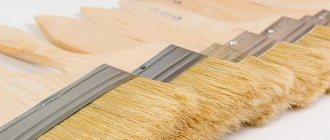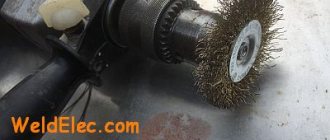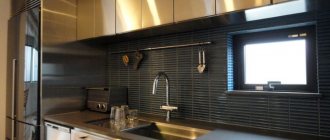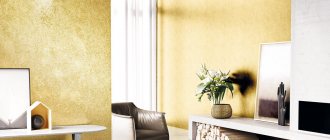Copper, brass and bronze are non-ferrous metals that are very similar in color and texture. It is very difficult to distinguish them without knowing their features.
On the Internet, images with these metals are most often labeled incorrectly, for example, under a photo with a copper bathtub it is written that it is bronze, or an image with a copper staircase is presented as brass.
How can you learn to understand them and never confuse them again?
As a designer, I feel these metals intuitively. In the photo, the metal is easiest to identify by color:
- if the item is pink or reddish in color, it is copper,
- if the yellow gold color is brass,
- if it has a greenish tint, it is bronze.
Copper
- This is a natural material, it is mined from iron ore, since there are almost no solid copper ingots left in nature.
Bronze
- is an alloy of copper and tin, and tin is the main component, it gives the alloy a greenish tint.
Brass
– an alloy of 70% copper and 30% zinc, i.e. copper is the main component.
Now I will tell you more about each metal:
Bronze color and its combination
Bronze color is one of the most attractive shades of brown.
The rich tone with a metallic sheen has not only aesthetic qualities, but also a rich cultural heritage, which includes an entire stage in the formation of humanity - the Bronze Age. Objects of art, jewelry, dishes, tools, weapons determined human well-being, so from time immemorial we have received an understanding of the nobility of this amazing shade, which is associated with labor, wisdom, and education. As a brown tone, bronze color has a natural gift of unity with nature, calmness and regularity. It is endowed with therapeutic properties in conditions of urban stress and sets a noble tone, both in clothing and in the interior.
Receiving technology
Bronze is a product of alloying copper with alloying additives.
The process takes place in electric induction furnaces or crucible furnaces:
- Metals from ore or recyclable materials (household, industrial waste) are used as a source charge in the production of the material.
- The furnace is heated, coal or flux is loaded, then copper.
- The copper melt is degassed (deoxidized).
- Heated refractory components-ligatures are added.
- The mass is stirred and heated until all the contents are melted.
- A deoxidizing agent (copper phosphorous) is added again to remove copper oxides.
- The final stage of bronze production is casting into molds.
The output is flat or three-dimensional ingots. They are sent to a rolling or forging shop.
Rolled metal products: pipe, strip, circle, bushings, rod, wire.
Complex combination with bronze color
A complex combination can be called a composition consisting of 3 or more shades. For example, bronze combines
- with dove color (2) forming a muted warm-cool contrast, which is very often used to emphasize the warm, bright nature of the main tone.
- with coniferous (3) - this is a natural, natural palette that is reminiscent of forest flavor. Soft, unobtrusive and relaxing. It also has a thermal contrast, but not as pronounced as with gray.
You can complement the combination with shades of beige, dark blue and dark gray.
Physical properties
The physical properties of an alloy depend on its composition and can vary significantly. Unlike brass, bronze has higher anti-corrosion resistance and anti-friction properties. It is more durable and has strong resistance to air, water, salt, and organic acids. Bronze is also easy to solder and weld.
- Density: 7800-8700 kg/m3.
- Melting point: 930С – 1140С.
- Color ranges from red to white.
- It has increased wear resistance and a low friction coefficient, copes even at low temperatures down to -250С.
- Some types of bronze have high vapor resistance, thermal conductivity and electrical conductivity and are used in equipment operating in harsh conditions.
Combination of bronze in palettes
Corrosion
This chemical process of oxidation creates not only problems, but also amazing textures, just like an artist. Smooth and sharp color transitions, a system of channels and protuberances, can intrigue your eye if you are ready to see beauty in all manifestations of nature. The palette consists of milky white, orange-beige, bronze, rust, grey-hyacinth, light silver.
Vintage bath
And while this shiny bathroom is most likely made of copper, it has a deep, vibrant brown that we've identified as bronze. In this case, a pair of blue-green and orange, brown is additional, so it looks very impressive. The color range includes snow white, saffron, bronze, burgundy, sea wave, and medium beige.
Bronze Graptosedum
A rare deep brown can also be found in plant colors, such as the thick-leaved graptosedum, which has pale yellow-green inflorescences. This composition shows us how beautiful these shades can look side by side. The composition includes pale lime, golden olive, copper, medium bronze, chocolate, blue-black-gray.
Vintage shutters
The old wood and patina on the bronze locks are a magnificent piece for vintage art lovers. Wooden carvings reveal the richness and luxury of brown tones from golden to taupe, thereby giving a fabulous dimension to the work. The palette includes medium beige, tan, bronze, patina, blue-green, gray with green undertones.
Classification, types
The variety of components made it necessary to streamline the bronze “nomenclature”. A classification of bronze has been developed on several grounds.
Compound
There are two types of bronzes:
- Tin. The number of alloy components is two or more, but tin dominates (second only to copper).
- Tinless. Others: lead, aluminum, silicon, beryllium, others.
The amount of copper determines the color of the alloy:
| Amount of copper (%): | Alloy Color: |
| 36 | Steel gray |
| 87 | Ocher yellow |
| 91 | Reddish |
Mode of application
Depending on the conditions and area of application, bronzes are distinguished:
- Plastic (deformable) . The material lends itself to all types of processing: rolling, forging, cutting.
- Molded. The product is heat-resistant, therefore it is produced by the foundry method. The output is castings of any configuration.
Both varieties are in equal demand.
Combination of bronze with other colors
Bronze is combined with medium-saturated shades. The best compositions are obtained with an autumn palette. The most luxurious combinations are based on the principle of thermal contrast, however, warm palettes, like the shade itself, have a mysterious appeal. As a brown shade, bronze enhances the color scheme of the couple, and as a complex, deep tone it fills the color scheme with harmony and natural tranquility.
The combination of bronze and pink is soft, romantic, and should not be harsh, even if the shade of pink is dark. Warm, moderately muted shades will look best in combination. The palette is made up of royal pink, cotton candy, strawberry, dark pink, and lingonberry.
Bronze combines with red as a warm, related shade. The color scheme looks natural due to the unifying red tone that is part of brown. Complex, muted red shades can be either warm or have a wine undertone. The combination includes alizarin, tomato, cherry, wine, dark burgundy.
A combination of bronze and orange colors. In fact, brown, and also so bright, is a dark shade of orange, so the combination with it will be in the same color scheme, the first will be a shadow of the second. The harmony of such a combination will be light, unobtrusive, and the composition will be deep. The color is composed of peach, sea buckthorn, golden copper, dark orange, and red.
How does bronze color combine with yellow? Yellow, like red, is a related shade to brown, as it is part of the latter. Shades of yellow lie in the light spectrum, so this combination will be built on light contrast and will look warm and attractive. The palette was made up of champagne, saffron, mustard, yellow gold, and bright gold.
Bronze and warm green - the combination is pleasant, enveloping, natural, like greenery and thin branches with fresh bark. The shades contain a unifying yellow, which supports harmony. However, it is better to take complex, soft tones of greenery versus bright and ringing ones. The combination includes green tea, chartreuse, protective, pine, brown-green.
Bronze is combined with cool green, creating a slight thermal contrast, but at the same time being in the natural composition zone. Cool shades of green should be light, not intrusive, with a significant admixture of gray, with the exception of emerald, which, like a precious stone, looks good with noble metal. The composition consists of water green, light gray-green, wormwood, gray-green, malachite.
The combination of bronze and blue is not only a representative of rich thermal contrast, but also an additional pair. This coloring is one of the most favorite in all areas. Marine shades are preferred, since bronze is built from a red-orange tone, and blue-green is complementary to it. The color scheme is built from gray-green-blue, thrush egg color, sea green, dark blue-green, blueberry.
Bronze is combined with purple - highlighting its red undertone, since it is what unites these colors. Soft lilac and red-violet shades add spice and sophistication to the main tone. The composition includes lilac-lilac, lilac amethyst, red-violet, plum, eggplant.
Bronze and brown are combinations in the same range, since the main tone is a pronounced brown tint. Such palettes are no less popular than green ones. Their interweaving seems fabulous to us, and the golden notes of some tones, along with dull dark ones, create a feeling of metallic shimmer. The composition is built of oak, tan, sepia, chocolate, dark chocolate.
Bronze goes with white, grey, beige and black as neutral shades. Each of them emphasizes this color in its own way: soft white brings lightness, beige - meekness, warm gray - smoothes, and cold - sharpens, black richly emphasizes. The palette consists of cream, beige, gray-beige, slate, wet asphalt.
Precautionary measures
Melting metals at home does not mean that this can be done simply in a residential area without any restrictions. For bronze casting, you will need a separate room that serves as a workshop, which must be equipped with all the necessary equipment and personal protective equipment for this process. The workshop must be equipped with a working fire extinguisher, and flammable materials and substances cannot be stored in the room itself.
In addition, melting bronze is considered a rather traumatic activity, so all the necessary stages of this procedure should be carried out only by a trained person.
Bronze color in clothes
The bronze color in clothing is modest but elegant. Most of all, it will suit the “autumn” color type, but “summer” girls can also choose it. As a color enhancer, this tone will add amazing color to your wardrobe while remaining natural, noble and stylish.
The shade works well in a business casual style, but can also be useful in an evening wardrobe, especially if the fabric is metallic-smooth or velvety-fleecy.
The image that this color creates can be called moderately romantic, moderately practical, but always sophisticated and intelligent. It is especially good at creating vintage images without being dull or gloomy.
Combination of bronze in clothes
The combination of bronze color in clothes is not flashy, but rather seasoned and aristocratic. Most often, the shade is supported by several brown and beige tones, this gives a feeling of gloss and shine. Great importance is given to the texture of a product of this shade; any unevenness, hairiness, or volume are welcomed, because, shimmering, this shade acquires the effect of internal light, which refreshes the appearance.
Cool shades are always a priority; they make the main tone warmer. Orange, yellow and gold tones continue it. Green, turquoise, purple look exotic next to it.
Install a bronze hood
A bronze hood is an unexpected decorative move. The kitchen immediately looks good and respectable. The shape of the hood is matched to the interior style; the color scheme of the kitchen does not play a big role - bronze will suit both a light background and a mixed one.
Photo: splendidhabitat.com
Photo: allarchitecturedesigns.com
Bronze color in the interior
Bronze in the interior looks expensive and elegant. Its closest relative is red terracotta.
As a shade close to dark, the tone looks contrasting with white. In such a composition it is worth paying attention to textures.
Green accents make a bronze-brown interior feel luxurious. It reveals exotic splendor.
Blue enhances the color of bright brown, emphasizing its warm, rich image, but at the same time the combination is more strict than the previous one.
There is a lot of this shade in the interior or just the intended accents - it doesn’t matter, the richness of bronze and at the same time its calming effect will allow you to bring pleasure in any quantity.
VIEW COMBINATIONS WITH SIMILAR SHADES (click on color)
Install a bronze bathtub
A bronze bathtub is downright chic. It is incredibly expensive, more expensive than a bathtub made of natural stone. And she, this bronze bathtub, openly declares this. It can both support the style and color scheme of the bathroom, and distinguish itself from other objects, as if opposing itself to them. A bathtub made of such metal can afford this.
Photo: babywatchome.com
Photo: mmdimensions.com










